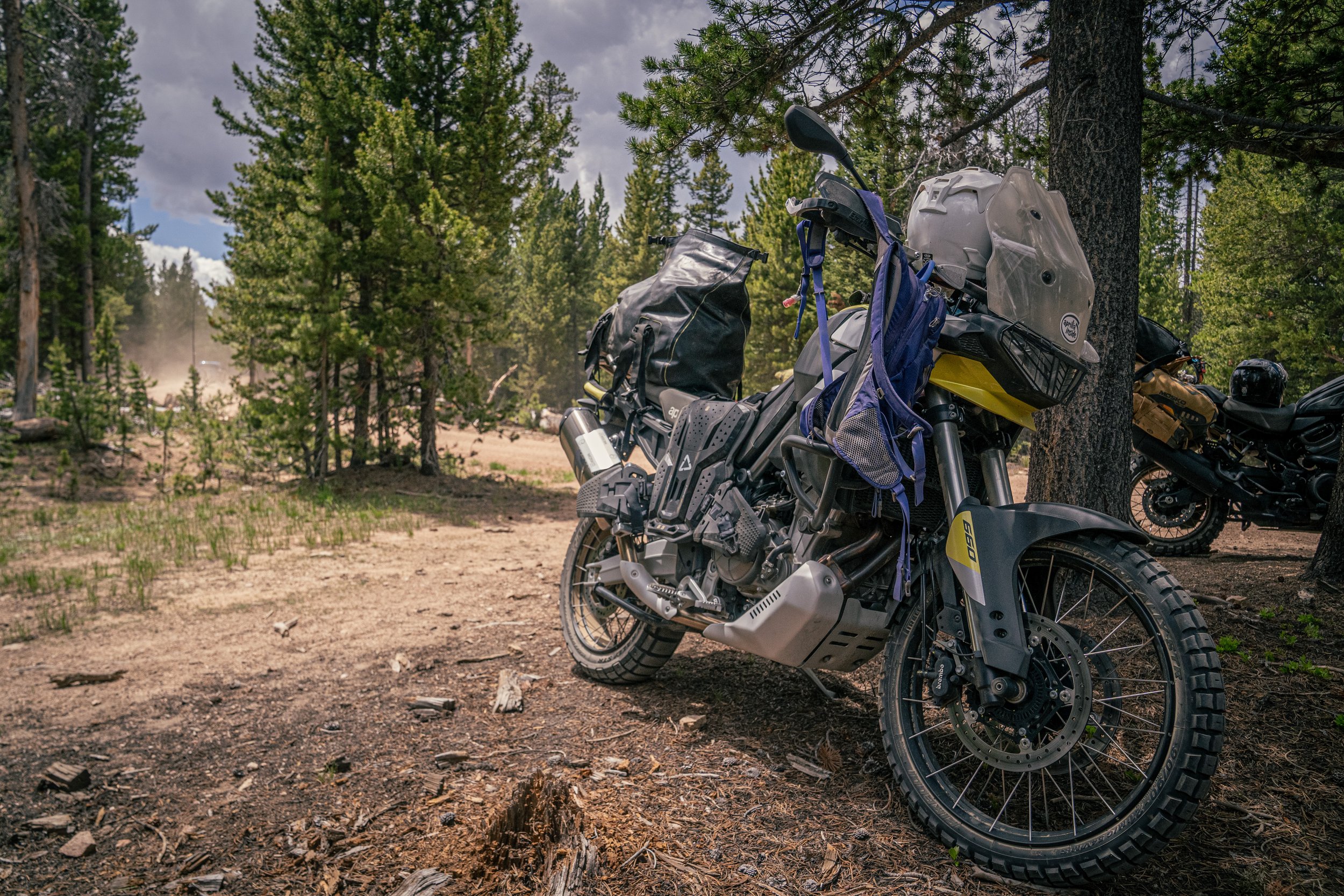
Rider Expectations
As you embark on this journey with us, it's important to remember that each tour will present a diverse range of challenges, from varying terrains and altitudes to unpredictable weather conditions. Be prepared for anything, as every twist and turn of the road may bring new surprises.
Throughout our tours, you can expect to experience a wide range of temperatures, with periods of scorching heat exceeding 80 degrees and chilly mountain passes dropping to the 40s. Saddle time will typically range from 5 to 7 hours per day, ensuring ample opportunity to soak in the sights and sounds of the journey.
Proper preparation is key to ensuring a safe and memorable tour experience. We encourage you to review the information provided below and reach out to us with any questions or concerns you may have. Your safety and enjoyment are our top priorities, and we're here to support you every step of the way.
Riding Gear
Required Gear:
Helmet: A DOT-approved helmet is mandatory for all riders.
Eye Protection: Protective eyewear, such as goggles or a face shield, is essential.
Gloves: Sturdy, full-fingered gloves for hand protection during the ride.
Boots: Over-the-ankle, durable riding boots for optimal foot and ankle support.
Recommended Gear
Full Set of Riding Gear: While not mandatory, a complete set of riding gear including body armor is highly recommended for added safety.
Hydration Pack: A 2-3 liter backpack-style hydration pack is strongly advised to ensure riders stay hydrated, especially during rides at high altitudes.
Individual Satellite Emergency Communications Device: It's recommended that each participant carry their own satellite emergency communications device for added safety and peace of mind. The guide will also carry one for the group.
Weather Considerations:
Be prepared for various weather conditions: From extreme heat and cold to sleet, hail, rain, and wind, weather can be unpredictable. Dressing in layers and bringing waterproof gear is advisable.
Altitude: Many rides will take us above 9,000 feet, with some passes nearing 13,000 feet. Riders should be prepared for potential altitude-related challenges and dress accordingly.
Bike Preparation
Service and Inspection:
Ensure your bike has been recently serviced and thoroughly inspected for safety.
Check the condition of wear items such as brakes, chains, and sprockets, and replace any that are worn or marginal.
Tires should have at least 50% tread remaining to handle varying terrain and conditions.
Bring Spares and Tools:
Pack typical spares that fit your bike, including spare levers, tire repair equipment (tube, plug kit, patches), and any other necessary components.
Carry tools specific to your bike's make and model to handle any on-the-road maintenance or repairs.
Importance of Preparation:
Remember, a breakdown can impact everyone on the tour, so it's crucial to be proactive in bike maintenance.
No one wants to be "that guy" causing delays or disruptions, so thorough preparation is key to ensuring a seamless ride for all participants.
By following these bike preparation guidelines, you'll not only enhance your own safety and enjoyment but also contribute to the overall success of the tour.
Additional Ride Rules
Additional Ride Rules
To ensure safety and harmony during our rides, please adhere to the following guidelines:
Ride Within Your Skill Level:
It's crucial to ride well within your skill level and not feel pressured to keep up with the group if it exceeds your capabilities. Safety always comes first.
Ride Right:
On both on and off-road sections, always stay to the right side of the trail or road to allow for smooth passing and minimize conflicts with oncoming traffic.
Ride Staggered:
When riding on paved and improved gravel roads, maintain a staggered formation at all times to ensure visibility and safety for all riders.
Maintain Spacing:
Maintain adequate spacing between riders, ensuring there's enough stopping distance and avoiding riding directly behind another rider to minimize dust inhalation.
No Passing the Lead Rider:
Respect the lead rider's authority and refrain from passing them at any point during the ride.
Sweep Position:
The sweep rider will always occupy the last position in the group to ensure no rider is left behind.
Passing Other Vehicles:
Only pass other vehicles when it's safe to do so and when the maneuver is clearly marked and communicated.
Waiting at Turns:
Wait for the next rider at every turn to ensure no one gets lost or misses a change in direction.
No Roosting Other Riders:
Avoid intentionally spraying other riders with dirt or debris (roosting), as it can be disruptive and potentially hazardous.
Helping with Downed Bikes:
Always wait for assistance when lifting a downed bike and be ready to lend a hand to help lift it safely.
Navigation
Bring Your Preferred Device:
Riders should bring their preferred navigation device, whether it's a GPS unit, smartphone with a navigation app, or any other tool they're comfortable using.
Download the route provided before the ride to ensure seamless navigation during the journey.
Be Prepared for Alternates:
In the event that an alternate route is necessary for any reason, riders must have the means to navigate to the destination independently.
Download Area Maps:
If using a phone app for navigation, download the area map before the ride to ensure offline access in areas with limited or no cellular coverage.
Rental Bikes:
We recommend brining your own navigation device and mount. A 1 inch Ram mount ball is available on most bikes.
By being prepared with your navigation device and downloading the necessary route information beforehand, you'll have the tools you need to stay on course and make the most of your adventure.
Group Ride Etiquette
Guide/Lead:
The lead rider is responsible for navigation and setting the pace of the ride.
No rider should pass the leader at any point during the ride.
Sweep:
The sweep rider will always remain at the back of the group and will not pass other riders.
The sweep's role is to ensure no rider is left behind and to provide assistance if needed.
Communication between the lead and sweep will be maintained to prevent the group from becoming too spread out.
Ride Order:
While the leader sets the overall pace, riders should gradually determine their preferred positions within the group.
Riders should refrain from passing others during the ride, but reordering can be discussed and decided upon during breaks.
Riders should wait at each turn until the next rider arrives.
Watch Your Wingman:
Each rider is responsible for the rider directly behind them, known as their "wingman."
Keep an eye on your mirror and ensure your wingman is keeping up. If they fall behind, wait for them to catch up or turn around to find them.
Stop at turns until your wingman arrives before continuing.
Gates:
If the group encounters a gate, the second rider (leader's wingman) will open it, and the third rider (the current wingman of the second rider) will close it.
This practice keeps the ride flowing smoothly, ensures the safety of animals, and provides an opportunity for a shuffle in ride order.
Guide Gear
Trauma/First Aid Kit:
Guides carry a comprehensive trauma and first aid kit, along with certification in wilderness first aid, to handle any medical emergencies that may arise during the ride.
Tire Repair Gear:
A full set of tire repair equipment is on hand to address any punctures or damage to tires, ensuring minimal downtime in case of a flat.
Jumper Cables:
Jumper cables are available to assist with any battery-related issues that may occur during the ride.
Tools:
Guides carry a selection of tools necessary for basic maintenance and repairs on the road, ensuring the group can address minor mechanical issues efficiently.
Spares for Rental Bikes:
Additional spare parts and components specific to rental bikes are carried by guides to facilitate any necessary repairs or replacements for participants using rental equipment.
Recovery Gear:
Recovery gear, such as straps and winches, is available to assist in extracting stuck or immobilized vehicles from challenging terrain.
Radios:
Guides are equipped with radios to maintain communication between the lead and sweep riders, ensuring the group stays together and coordinated throughout the ride.
Luggage
Each rider needs to provide their own bike luggage to carry personal items for the tour.
For rental bikes a selection of bags are available for rent.
Rider Fitness
Duration of Rides:
Be prepared for a minimum of 5 to 7 hours of riding per day, with varying terrain and conditions.
Strenuous Sections:
Some sections of the ride may be strenuous, requiring physical exertion and technical skill.
It's not uncommon for bikes to be dropped or encounter challenging obstacles along the way.
Realistic Assessment:
We encourage all participants to be realistic about their level of fitness and ability to handle the physical demands of adventure riding.
If you have any concerns about your fitness level or ability to cope with the activity, please communicate with us beforehand so we can make appropriate accommodations.

